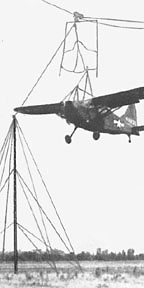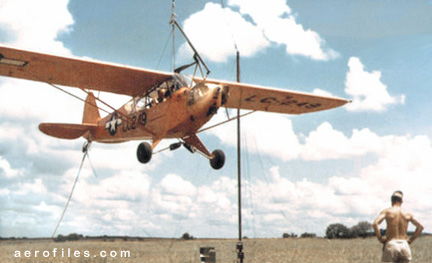
A Runway On a Rope

 During WW2, lightplanes rigged with an overhead hook could "land" by snagging a sling hung from a long cable and roll to a braked halt like the department store change baskets of long ago. To take off, they changed slings, opened the throttle and, at flying speed, pulled a lanyard which freed the plane from the sling.
During WW2, lightplanes rigged with an overhead hook could "land" by snagging a sling hung from a long cable and roll to a braked halt like the department store change baskets of long ago. To take off, they changed slings, opened the throttle and, at flying speed, pulled a lanyard which freed the plane from the sling.

This idea was dreamed up by Capt James H Brodie of the USAAF Transportation Corps during the dark days of the Battle of the Atlantic. Hundreds of successful landings and takeoffs erased the circus flavor from a project which, on paper, seemed like the doings of a pulp fiction writer.

So foreign to normal procedure was the system that Capt Brodie had difficulty obtaining test pilots for the first rig. Transient AAF pilots temporarily stationed at New Orleans, where the rig first was constructed, would volunteer for the assignment sight unseen. but after looking at the slender wire on which their plane would land, most politely backed out.
Like a big clothesline, the tight, overhead cableway of the portable ground rig stretched between two 65' tubular-steel masts at each end of the wire. N-shaped bridle cables connected the masts and the main cable, leaving both ends open to approach.

A single-wheel landing trolley designed for easy rolling gave a pendulum effect upon acceleration, reducing inertia forces. Shackled to the trolley was the landing sling—three loops of nylon rope affording a six-foot target to incoming planes. Engagement of just one of the loops was sufficient for a successful landing. An arresting brake resisted flying momentum on the principle of a giant fishing reel. Brake force was applied gradually, reaching a maximum after the plane traveled about 50' along the cableway, in a constant negative acceleration of about one-third gravity. Arresting line tension was varied to correspond to weights of different planes.

The takeoff trolley consisted of a wheel, a wooden friction shoe, and an emergency release. The takeoff sling was a four-foot length of nylon rope with an eye and shackle at the top, a lifting ring in the middle, and a bottom stirrup. The plane's hook was put into the stirrup, a lifting derrick carried it upward by the middle ring, and the top shackle was attached to the trolley.

A travel release consisting of a long hold-back line and a spring-loaded trip prevented planes from beginning a run until the engine was at full power. A pull on the lanyard attached to the trip lever disconnected the plane from the hold-back. An emergency release functioned if the plane has not been released from the trolley before the end of the cableway on its takeoff run. Without wind, an average lightplane took off from the cable in 400'; with wind, it was off in 200'.

Independent of terrain, the Brodie rig provided a good landing and takeoff site in most unlikely country—jungles, mountains, marshes, any place where construction of a landing strip was difficult or not economical. It was perfect for forward military positions because of its camouflage value—from above 500' it was extremely difficult to see, and even if spotted, it structurally was an elusive target.

Weighing less than 7,000 pounds, including tools and tackle, the rig was highly portable, small and light enough to be carried in cargo planes, along with a nine-man crew, and parachuted into a location. Where roads existed, two 2-1/2-ton trucks could haul everything. With hand tools and tackle, the rig could be made ready for landings and takeoffs in about 12 hours. At sea, the 600' long cable was supported by booms, kingposts, and bracing struts, elevated and outboard parallel on the port side of the ship.

 
The system was applied to landing ships for lightplane support of amphibious landing operations with outstanding success. During test maneuvers all other planes of a simulated task force were grounded by fog, but two liaison planes attached to an LST fitted with the Brodie line were aloft regularly acting as observers.

With $10,000 from the Transportation Corps, Brodie began his first rig at New Orleans in April 1943 to simulate shipboard conditions. By July he was entreating wary transient army pilots to conduct tests. Army service pilot Lt C C Wheeler made the first takeoff in late August, and the first round trip was made on 3 Sept 1943, by Maj James D Kemp, a B-26 pilot awaiting shipment overseas.

By mid-September, the first regularly assigned Brodie system test pilot arrived—F/O Raymond Gregory, who approached the testing with enthusiasm. With Brodie as passenger, Gregory had come in for a landing pass and forgot about the sag in the center of the cable and kept too much altitude. The prop hit the cable, but Gregory brought his L-5 to a safe emergency landing under the rig.
Experimentation in those days was by trial and error. Brodie's regular assignment of redesigning cargo ships made him work out his system during off hours. Principal mechanical hurdles were development of adequate brakes and reduction of shock getting the landing trolley accelerated. Braking was finally refined by using an aluminum reel, two hydraulic automobile brake assemblies, and automatic brake delay screw, a tension adjuster and a gauge for determining line tension. The delay screw permitted rotating parts to become accelerated to airplane speed before applying drag.

Brodie designed the trolley in a half-moon, which allowed the lower half to pendulum forward before the trolley wheel actually was set in motion. The hook-arm swung to a horizontal position and then telescoped outward about two feet upon contact with the landing sling.

Late in 1943 Brodie obtained the cargo ship, City of Dalhart, with which to experiment on modification of the apparatus for actual sea landings. In December, a series of landings and takeoffs were successfully made with a Stinson L-5, bringing vindication of the months of work on what many officials called too fantastic a project on which to waste money.

Although its combat use was limited to one ship, the system proved its feasibility at Saipan and Okinawa, but only eight of 25 contracted LSTs were so equipped when the war ended. Success was formally proclaimed in 1945 with the presentation of Legion of Merit medals to Brodie and Gregory.

Commercially, the future of the system was as flamboyant in possibilities as was its wartime use. Brodie claimed a rig capable of handling planes much heavier than L-5s could be built, up to 7,000-pound airplanes. He foresaw light cargo routes utilizing his rigs to reduce the amount of fuel spent between landings—by decreasing fuel load, payloads would increase proportionately. Grovers and ranchers would use the system to visit obscure acreage. Private individuals in the bush would set up their own airport in wooded or hilly back country.

Seemingly practical, and definitely proven, the idea never played out.

 |

 During WW2, lightplanes rigged with an overhead hook could "land" by snagging a sling hung from a long cable and roll to a braked halt like the department store change baskets of long ago. To take off, they changed slings, opened the throttle and, at flying speed, pulled a lanyard which freed the plane from the sling.
During WW2, lightplanes rigged with an overhead hook could "land" by snagging a sling hung from a long cable and roll to a braked halt like the department store change baskets of long ago. To take off, they changed slings, opened the throttle and, at flying speed, pulled a lanyard which freed the plane from the sling.
